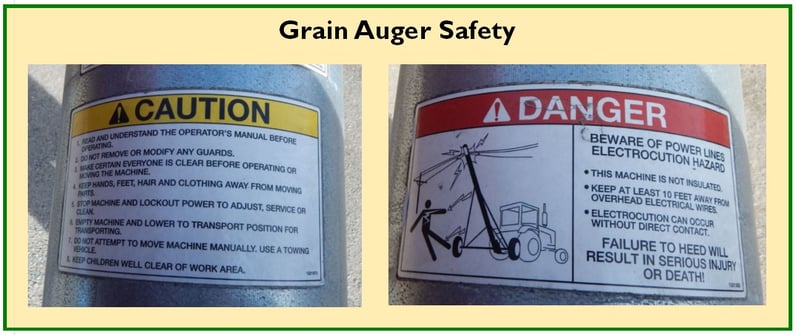Grain augers are a necessity on many agricultural operations and deserve a high level of attention due to the many safety risks associated with them. Common injuries include amputations, entanglements, electrocution, lacerations, and broken bones. Which is why augers have been recognized to be one of the more dangerous pieces of equipment per hour of use.

Training and safety operational policies around grain augers can set you up to prevent injuries in and around grain augers. Here are 3 safety tips to manage risks around gain augers:
Shields and Guards
Inspect augers to ensure that all protective shields supplied by the manufacturer are in place and in good working condition. Guards around PTO shafts and drive mechanisms are essential. In accidents involving power take-off entanglements, shielding is either absent or damaged in 70% of the of the cases. To prevent entanglements, workers should not wear loose or tattered clothing, clothing with draw strings, straps, jewelry and long, untied hair. Make it known, there is NEVER a time where someone can step over a running PTO shaft.
In addition, guards around the exposed flighting must also be guarded properly. The intake screen is an important safety feature to allow grain to flow through but keep hands and feet out. Guards should be strong, secure and without any compromising damage or deformation. Contact with or entanglement in the exposed flighting at the intake end of the auger’s shaft often results in amputations.
Establish A Safe Work Zone
Moving grain with an auger has multiple hazards including moving parts, loud noise and possible trip hazards to name a few. Establish a work zone to limit the number of people and distractions while working in the area. Use barriers (e.g., saw horses, bales, cones, twine) and signage to keep others not involved in the operation out of this dangerous area. Keep visitors and family members at a safe distance until equipment has been shut down. Children under 18 should not operate an auger.
Electrocutions
Train workers to always lower grain augers to the horizontal or transport position. It is also imperative that they observe the presence and location of overhead power lines before moving and raising in the next location. The practice of moving a raised auger may save time, but it exposes the worker to the hazards of upending and electrocution. Electrocution is a frequent result of moving a raised auger and coming into contact with electrical wires.
Changing Behavior
Many agricultural workers are aware of some of the safety risks associated with grain augers. Train employees to adequately recognize the degree of risk and to choose behaviors that minimize potential injuries.

